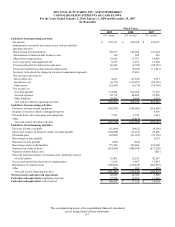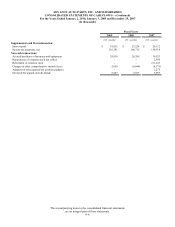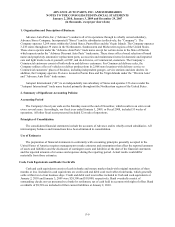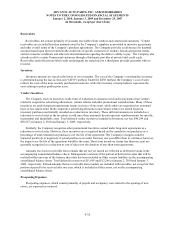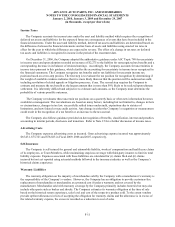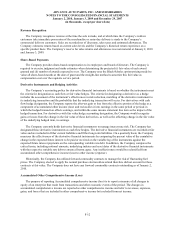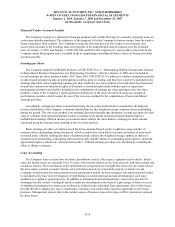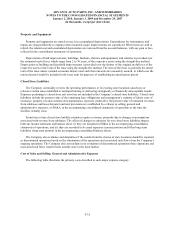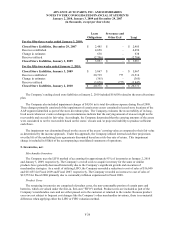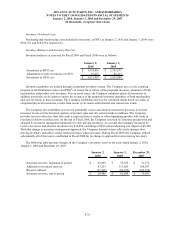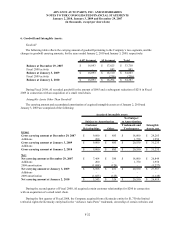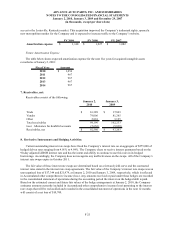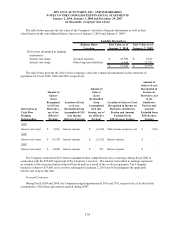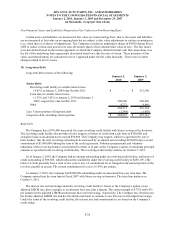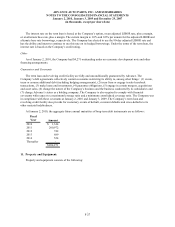Advance Auto Parts 2009 Annual Report Download - page 70
Download and view the complete annual report
Please find page 70 of the 2009 Advance Auto Parts annual report below. You can navigate through the pages in the report by either clicking on the pages listed below, or by using the keyword search tool below to find specific information within the annual report.ADVANCE AUTO PARTS, INC. AND SUBSIDIARIES
NOTES TO THE CONSOLIDATED FINANCIAL STATEMENTS
January 2, 2010, January 3, 2009 and December 29, 2007
(in thousands, except per share data)
.
F-17
Effective July 18, 2009 (the Company’s second quarter), the Company adopted FSP No. FAS 157-4,
“Determining Fair Value When the Volume and Level of Activity for the Asset or Liability Have Significantly
Decreased and Identifying Transactions That Are Not Orderly” (currently included in ASC Topic 820-10-65-4).
This FSP provides guidance for estimating the fair value of an asset or liability when the volume and level of
activity for the asset or liability have significantly decreased, as well as guidance on identifying circumstances that
indicate a transaction is not orderly. It also requires disclosure in interim and annual periods of the inputs and
valuation techniques used to measure fair value and a discussion of changes in valuation techniques and related
inputs, if any, during the period. The adoption had no impact on the Company’s consolidated financial statements.
Effective July 18, 2009 (the Company’s second quarter), the Company adopted FSP No. FAS 107-1 and
APB 28-1, “Interim Disclosures about Fair Value of Financial Instruments” (currently included in ASC Topic 825-
10-65-1). This FSP amends SFAS No. 107, “Disclosures about Fair Value of Financial Instruments,” to require
disclosures about fair value of financial instruments for interim reporting periods as well as in annual financial
statements. This FSP also requires disclosure about the methods and significant assumptions used to estimate the fair
value of financial instruments and changes in those methods and significant assumptions, if any, during the period.
The adoption had no impact on the Company’s consolidated financial statements other than the additional
disclosures.
Effective July 18, 2009 (the Company’s second quarter), the Company adopted SFAS No. 165, “Subsequent
Events” (currently ASC Topic 855-10). This statement sets forth general standards of accounting for and disclosure
of events that occur after the balance sheet date but before financial statements are issued. The Company evaluated
all activity through March 2, 2010 (the issuance date of the financial statements) and concluded that no subsequent
events have occurred, other than the Company’s subsequent repurchase of its common stock as discussed in Note 13,
that would require recognition in the consolidated financial statements or disclosure in the related notes to the
consolidated financial statements.
In June 2008, the FASB Issued EITF No. 08-3, “Accounting by Lessees for Nonrefundable Maintenance
Deposits” (currently ASC Topic 840). EITF 08-3 requires that nonrefundable maintenance deposits paid by a lessee
under an arrangement accounted for as a lease be accounted for as a deposit asset until the underlying maintenance
is performed. When the underlying maintenance is performed, the deposit may be expensed or capitalized in
accordance with the lessee’s maintenance accounting policy. Upon adoption entities must recognize the effect of the
change as a change in accounting principle. The adoption of EITF 08-3 had no impact on the Company’s
consolidated financial statements.
In April 2008, the FASB issued FASB Staff Position No. FAS 142-3, “Determination of the Useful Life
of Intangible Assets” (currently ASC Topic 350), which amends the factors that must be considered in developing
renewal or extension assumptions used to determine the useful life over which to amortize the cost of a recognized
intangible asset under SFAS 142, “Goodwill and Other Intangible Assets.” The FSP requires an entity to consider its
own assumptions about renewal or extension of the term of the arrangement, consistent with its expected use of the
asset, and is an attempt to improve consistency between the useful life of a recognized intangible asset under SFAS
142 and the period of expected cash flows used to measure the fair value of the asset under SFAS 141, “Business
Combinations” (collectively now under ASC Topic 805). The Company adopted the provisions of FSP FAS 142-3
effective January 4, 2009. The adoption of the FSP had no impact on the Company’s consolidated financial
statements.
In December 2007, the FASB issued SFAS No. 141R, “Business Combinations” (collectively now under ASC
Topic 805), which replaces SFAS No. 141, “Business Combinations.” SFAS No. 141R, among other things,
establishes principles and requirements for how an acquirer entity recognizes and measures in its financial
statements the identifiable assets acquired, the liabilities assumed and any controlling interests in the acquired entity;
recognizes and measures the goodwill acquired in the business combination or a gain from a bargain purchase; and
determines what information to disclose to enable users of the financial statements to evaluate the nature and
financial effects of the business combination. Costs of the acquisition will be recognized separately from the
business combination. SFAS No. 141R applies to business combinations for fiscal years beginning after December


